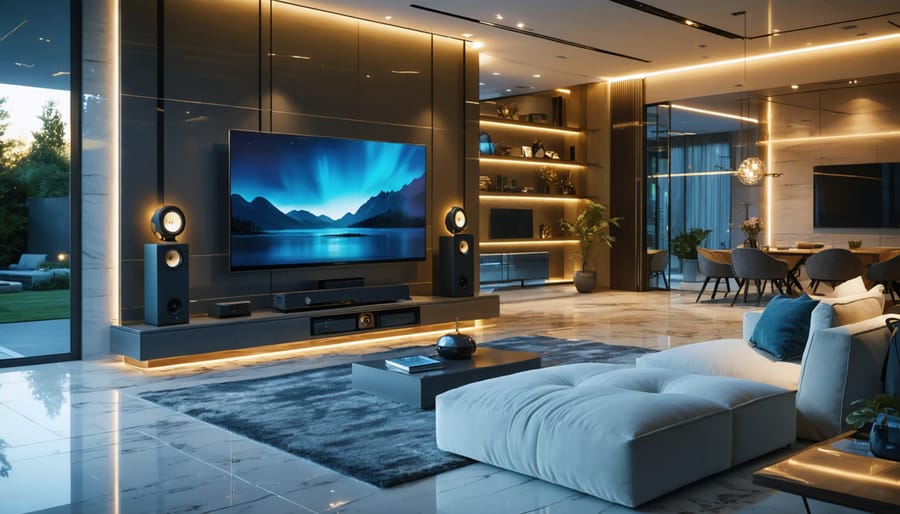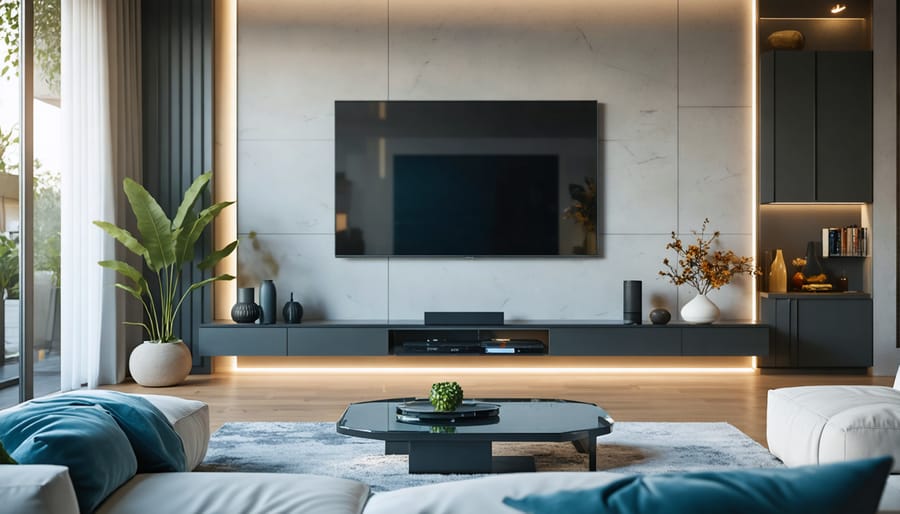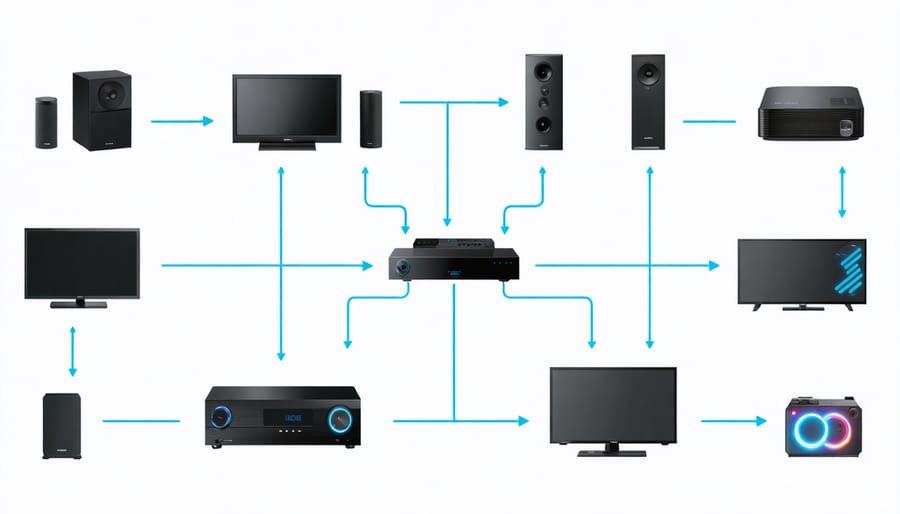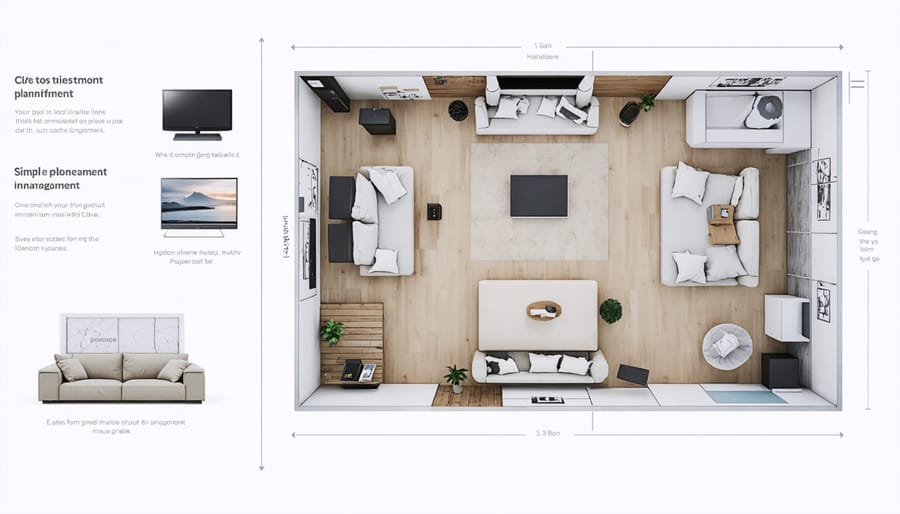
Transform Your Living Room Into a Smart Entertainment Paradise
Transform your living room into an immersive entertainment hub by integrating smart devices that seamlessly connect your audio, video, and ambient lighting systems. Modern smart home entertainment goes beyond basic TV and speakers, creating personalized experiences that respond to voice commands, adapt to your viewing habits, and enhance every movie night, gaming session, or music playlist.
Today’s intelligent entertainment systems unite 4K projectors, multi-room audio, automated lighting scenes, and streaming services into one cohesive ecosystem controlled from your smartphone or tablet. Whether you’re hosting a movie marathon, streaming your favorite playlist, or gaming with friends, these synchronized components work in harmony to deliver theater-quality experiences while maintaining the comfort and convenience of home.
The real magic happens when your entertainment system anticipates your needs – automatically dimming lights when you start a movie, adjusting sound profiles based on content type, and even suggesting content based on your viewing patterns. This isn’t just about convenience; it’s about creating memorable experiences that transform how you enjoy entertainment at home.

Core Components of a Smart Entertainment System
Smart TV and Display Solutions
Today’s smart TVs and display solutions offer an incredible viewing experience that can transform your home entertainment setup. The latest 4K and 8K TVs deliver stunning picture quality with vibrant colors and sharp details that make movies and games come alive. These smart displays come equipped with built-in streaming capabilities, voice control features, and seamless integration with other smart home devices.
For those seeking a truly cinematic experience, modern smart projectors provide an excellent alternative to traditional TVs. These devices can create massive screen sizes while maintaining impressive picture quality, and many come with built-in streaming apps and wireless connectivity options.
The newest display technologies include OLED and QLED panels, offering deeper blacks and more vivid colors than ever before. Many smart TVs now feature AI-powered picture optimization that automatically adjusts settings based on room lighting and content type. Gaming enthusiasts will appreciate features like variable refresh rates and low latency modes, while movie buffs can enjoy Dolby Vision and HDR support for the ultimate viewing experience.
Smart ambient lighting features and automatic content recognition make these displays even more intuitive, creating an immersive atmosphere that responds to what’s playing on screen.
Audio Excellence
Transform your home into an acoustic paradise with today’s smart audio solutions. Modern soundbars have evolved beyond simple TV speakers, now offering voice control, WiFi connectivity, and seamless integration with your smart home ecosystem. Premium options from brands like Sonos and Bose can detect your room’s layout and automatically adjust their output for optimal sound distribution.
Wireless surround sound systems have eliminated the hassle of running cables through walls and under carpets. Many systems now support Dolby Atmos and DTS:X, creating an immersive 3D soundscape that brings movies and music to life. With smart features like room calibration and preset modes for movies, music, and gaming, these systems adapt to your entertainment needs at the touch of a button.
Multi-room audio has never been easier, thanks to wireless speakers that sync perfectly throughout your home. Group speakers together for whole-house audio or play different content in each room. Most systems support popular streaming services and can be controlled through smartphone apps or voice commands, making it simple to set the perfect mood in any space.
Smart Hub and Control Center
A smart hub serves as the brain of your entertainment system, allowing you to control multiple devices through a single interface. Popular options like Amazon Echo, Google Home, or Apple HomeKit let you manage your TV, sound system, lighting, and other connected devices with simple voice commands or smartphone apps. These hubs can create custom scenes – for instance, saying “Movie Time” could dim the lights, lower your smart blinds, and switch your TV to the perfect settings. Many modern smart TVs come with built-in voice assistants, but a dedicated hub offers more versatility and better integration with your entire home system. For seamless control, consider placing your hub in a central location with good wireless coverage throughout your entertainment space.
Integration and Automation Features

Voice Control and Smart Assistants
Voice control has revolutionized how we interact with our entertainment systems, making it easier than ever to manage your media without lifting a finger. Popular smart assistants like Amazon Alexa, Google Assistant, and Apple’s Siri can seamlessly integrate with your entertainment setup, allowing you to control everything from volume adjustment to content selection using simple voice commands.
To get started, ensure your smart TV or streaming device supports voice control functionality. Most modern smart TVs come with built-in voice assistants, while others may require a compatible smart speaker or remote. Common voice commands include “Play Netflix,” “Pause the movie,” “Turn up the volume,” or “Switch to HDMI 2.”
For the best experience, position your voice-enabled device where it can easily hear you, typically within 15-20 feet of your viewing area. Consider creating custom voice routines to handle multiple actions with a single command – like “Movie Time” to dim the lights, lower the blinds, and turn on your TV to your preferred streaming service.
Remember to speak clearly and use the specific wake word for your chosen assistant. While voice control is incredibly convenient, keeping a traditional remote nearby as backup is always wise.
Lighting and Ambiance Control
The magic of a home theater experience isn’t just about sound and picture – lighting plays a crucial role in creating the perfect ambiance. With smart lighting integration, your entertainment system can automatically adjust the room’s illumination based on what you’re watching or doing.
Imagine pressing ‘play’ on your favorite movie, and the lights gradually dim to your preferred viewing level. When you pause, they brighten slightly for comfortable movement around the room. For gaming sessions, bias lighting behind your TV reduces eye strain while adding a cool, immersive glow.
Modern smart bulbs and light strips can sync with your content, creating dynamic lighting effects that extend the on-screen action into your room. During sports events, your lights can flash your team’s colors when they score, or during music playback, they can pulse with the beat.
Control options are equally impressive – use voice commands, your smartphone, or program specific scenes for different activities. Want a bright, energetic setting for party games? Or a cozy, warm glow for movie night? It’s all possible with a few taps or words.
Custom Scenes and Automation
Transform your entertainment experience by creating customized scenes through smart home automation. Imagine pressing a single button to set the perfect movie night ambiance: your TV powers on, lights dim to 20%, soundbar activates, and motorized blinds lower for that authentic cinema feel.
Create different scenes for various activities: “Game Night” might include brighter lighting and surround sound optimization for multiplayer gaming, while “Music Mode” could adjust your speaker equalizer settings and create subtle mood lighting for the perfect listening experience.
Voice commands make these scenes even more convenient. Simply say “Hey Google, Movie Time” or “Alexa, start Game Mode” to instantly transform your space. You can also schedule scenes to activate automatically – have your morning news ready with the TV turned on and blinds open when you wake up.
For sports fans, create a “Game Day” scene that synchronizes your TV with smart lighting that flashes your team’s colors when they score. Add smart plugs to control snack warmers or mini-fridges, making entertainment seamless and interactive.
Remember to save your favorite settings and fine-tune them over time as you discover what works best for your lifestyle.
Setup and Installation Tips
Planning Your Layout
Before diving into component installation, taking time to plan your entertainment system layout is crucial for both functionality and aesthetics. Start by identifying your room’s focal point – typically where your TV or projector screen will be mounted. Consider natural light sources and seating arrangements to minimize glare and ensure optimal viewing angles for everyone.
Map out your power sources and plan cable routes early. You’ll want to keep cables hidden while ensuring all components can reach their power supplies and connect to each other. Consider installing cable raceways or running wires through walls for a cleaner look. If you’re planning in-wall installation, always consult with an electrician to ensure compliance with local building codes.
Speaker placement deserves special attention for the best audio experience. For surround sound systems, position your center channel at ear level when seated, place front speakers at 45-degree angles from your main viewing position, and set rear speakers slightly behind your seating area. Subwoofers are more flexible but generally work best in room corners or along walls.
Don’t forget to leave adequate ventilation space around components that generate heat, like amplifiers and gaming consoles. Include easy access to components that need regular interaction, such as gaming systems or media players. Consider future expansion too – leave some extra space and power outlets for additional components you might add later.

Network Requirements
A robust network infrastructure is the backbone of any smart home entertainment system. Start with a high-speed internet connection of at least 100 Mbps, though 300 Mbps or higher is recommended for households that stream 4K content or have multiple users. Your router should be Wi-Fi 6 (802.11ax) compatible to handle the increased bandwidth demands of streaming devices, gaming consoles, and smart TVs.
Strategic router placement is crucial – position it centrally and elevated, away from metal objects and thick walls. For larger homes or multi-story setups, consider a mesh Wi-Fi system to eliminate dead zones and ensure consistent coverage throughout your entertainment spaces.
Hardwiring critical components via ethernet cables provides the most stable connection. Run CAT6 or CAT6a cables to your main TV, gaming consoles, and streaming devices when possible. This reduces latency and prevents buffering during peak usage times.
Network segmentation can improve performance by creating a dedicated VLAN (Virtual Local Area Network) for your entertainment devices. This separates them from other smart home devices and general internet traffic, ensuring smoother streaming and gaming experiences.
Don’t forget about network security. Use WPA3 encryption, create a strong password, and regularly update your router’s firmware to protect your entertainment system from potential threats.
Budget-Friendly Implementation
Building a smart home entertainment system doesn’t have to break the bank. By implementing budget-friendly smart solutions, you can create an impressive setup gradually while managing costs effectively.
Start with a smart TV or streaming device as your foundation. Many affordable smart TVs now come with built-in streaming capabilities and voice control features. If your existing TV works well, simply add a budget-friendly streaming stick like Roku or Amazon Fire TV Stick to make it smart-enabled.
Consider these cost-effective steps for building your system:
1. Begin with basic smart speakers (like Amazon Echo or Google Nest Mini) for voice control and music streaming. These often go on sale during major shopping events.
2. Add smart plugs to control existing entertainment devices. They’re inexpensive and can make traditional equipment smart-compatible.
3. Invest in affordable LED light strips for ambient lighting. These can transform your viewing experience without significant expense.
4. Look for refurbished or previous-generation components. They often offer similar functionality at reduced prices.
5. Subscribe to streaming services strategically. Share family plans and rotate subscriptions based on viewing habits.
To maximize your budget:
– Wait for seasonal sales and holiday promotions
– Compare prices across different retailers
– Check for bundle deals that combine multiple components
– Consider open-box items from reputable sellers
– Join loyalty programs for additional savings
Remember to prioritize essential components first and expand your system over time. This approach allows you to spread costs while ensuring each addition integrates seamlessly with your existing setup. Many smart home devices are designed to work together, so you can build a comprehensive system piece by piece without compromising on quality or functionality.
As we’ve explored throughout this guide, smart home entertainment systems represent the perfect blend of convenience, innovation, and immersive experiences. By integrating various components like smart TVs, sound systems, streaming devices, and voice controls, you can create a seamlessly connected entertainment hub that transforms your living space.
Remember that successful implementation depends on careful planning, understanding your specific needs, and choosing components that work well together. While the initial investment might seem substantial, the long-term benefits of enhanced functionality, energy efficiency, and improved home value make it worthwhile.
To future-proof your system, consider investing in devices that support the latest connectivity standards and can receive regular software updates. Look for products from established manufacturers with good track records for long-term support. It’s also wise to choose systems with open protocols that can integrate with various platforms, giving you more flexibility as technology evolves.
Start small if needed, and expand your system gradually. This approach allows you to learn each component thoroughly and make informed decisions about future additions. Keep in mind that the smart home industry continues to evolve rapidly, so leaving room for upgrades and new technologies in your setup is essential.
With proper planning and implementation, your smart home entertainment system will provide years of enjoyment while staying relevant in our increasingly connected world.
